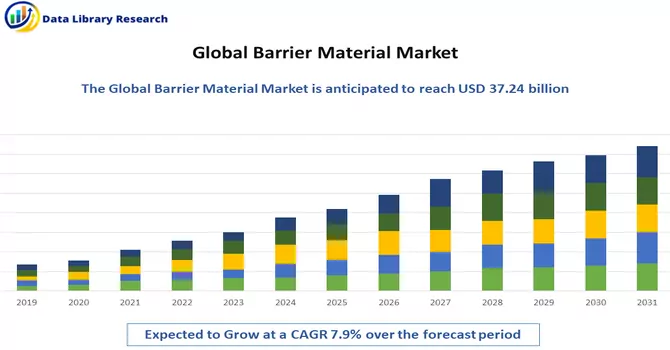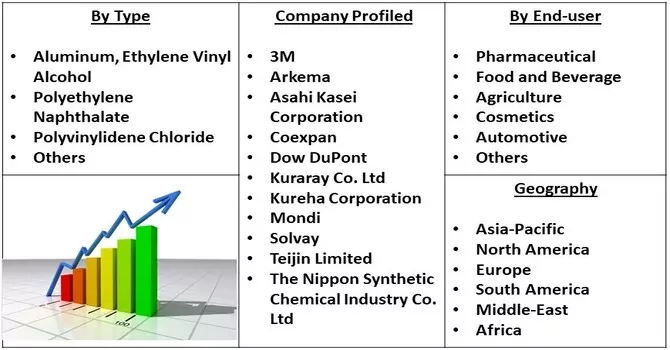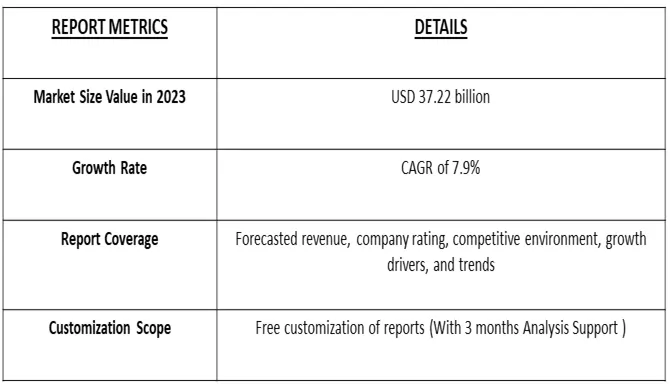The market for barrier films is approximated to be USD 37.24 billion in 2023, and it is projected to reach a CAGR of 7.9% over the forecast period, 2024-2031.

Get Complete Analysis Of The Report- Download Free Sample PDF
Barrier materials have become integral components across various industries, playing a pivotal role in enhancing product shelf life, quality, and safety. These materials are designed to act as protective barriers against external elements such as moisture, gases, light, and contaminants, preventing the degradation of sensitive products like food, pharmaceuticals, and electronic components. The market for barrier materials is witnessing substantial growth as a result of increasing consumer awareness regarding the importance of product preservation and the stringent regulatory requirements for packaging in sectors such as food and healthcare.
With continuous advancements in material science and packaging technologies, barrier materials are evolving to meet the ever-growing demand for extended product life, improved sustainability, and enhanced protection against environmental factors, positioning them as critical contributors to the advancement of modern packaging solutions. The robust growth of the barrier material market is primarily propelled by the escalating demand for extended product shelf life, increased focus on sustainability, and the stringent regulatory requirements governing packaging across diverse industries. As consumers increasingly prioritize freshness and quality, particularly in sectors like food and healthcare, there is a growing need for advanced packaging solutions that provide an effective barrier against external factors such as moisture, gases, and contaminants. Barrier materials, with their ability to enhance product preservation and maintain integrity, are witnessing heightened adoption. Moreover, the global emphasis on sustainable and eco-friendly packaging materials is driving innovations in barrier materials that offer both high performance and environmental responsibility. This convergence of consumer preferences, regulatory standards, and sustainability goals positions barrier materials as essential elements in shaping the future of packaging solutions across various sectors.
Market Segmentation: The market is segmented by Type (Aluminum, Ethylene Vinyl Alcohol, Polyethylene Naphthalate, Polyvinylidene Chloride, and Other Types), End-user Industry (Pharmaceutical, Food and Beverage, Agriculture, Cosmetics, Automotive, and Other End-user Industries), and Geography (Asia-Pacific, North America, Europe, South America, and Middle-East and Africa).

For Detailed Market Segmentation - Download Free Sample PDF
The market for barrier materials is currently characterized by several notable trends reflecting the evolving landscape of packaging solutions. One significant trend is the increasing adoption of sustainable and eco-friendly barrier materials in response to heightened environmental consciousness. Consumers and industries alike are prioritizing packaging solutions that minimize environmental impact, leading to innovations in barrier materials with improved recyclability and biodegradability. Additionally, there is a growing emphasis on smart and active packaging technologies within the barrier material market. These technologies incorporate features such as oxygen scavengers and temperature-sensitive indicators, enhancing the functionality of barrier materials for improved product safety and quality. Furthermore, the rise of e-commerce is driving the demand for robust and protective packaging solutions, stimulating innovations in barrier materials designed to withstand the challenges of shipping and handling. The convergence of sustainability, advanced technologies, and e-commerce dynamics is shaping the trajectory of the barrier material market, influencing the development of cutting-edge solutions that cater to evolving consumer and industry needs.
Market Drivers:
The growing preference for convenience and ready-to-eat food items, coupled with busy lifestyles
The contemporary market landscape is marked by a discernible shift in consumer preferences, driven by a growing inclination towards convenience and ready-to-eat food products, particularly in the context of increasingly hectic lifestyles. As individuals grapple with time constraints, the demand for easily accessible, quick, and hassle-free meal options has surged. This shift is fundamentally altering the dynamics of the food industry, prompting the need for innovative packaging solutions that ensure the preservation of product freshness, taste, and nutritional value. The preference for on-the-go and ready-to-consume food items is a key driver for the adoption of advanced packaging materials, including barrier materials, which play a pivotal role in extending the shelf life of perishable goods, ensuring convenience without compromising quality in the fast-paced modern lifestyle
The pharmaceutical industry's focus on maintaining the efficacy and safety of drugs is fueling the demand for advanced barrier materials in pharmaceutical packaging
The pharmaceutical industry's unwavering commitment to ensuring the efficacy, safety, and integrity of drugs has become a primary driver fueling the demand for advanced barrier materials in pharmaceutical packaging. The need to shield pharmaceutical products from external elements such as moisture, light, and gases is paramount to preserving their stability and effectiveness. As regulatory standards become increasingly stringent to safeguard patient well-being, the adoption of high-performance barrier materials has emerged as a critical strategy. These materials act as a protective shield, preventing degradation and maintaining the quality of pharmaceuticals throughout their shelf life. The growing emphasis on pharmaceutical packaging integrity underscores the vital role that advanced barrier materials play in meeting the industry's exacting requirements and ensuring the safe delivery of high-quality medications to patients worldwide.
Market Restraints:
The barrier material market faces certain constraints that impact its growth trajectory. One significant restraint is the challenge of balancing performance with sustainability, as there is a growing demand for eco-friendly packaging solutions. Striking the right balance between creating effective barrier materials and ensuring environmental responsibility poses a complex challenge for manufacturers. Additionally, the cost of advanced barrier materials can be a limiting factor, particularly for small and medium-sized enterprises, hindering widespread adoption. Furthermore, the evolving regulatory landscape and compliance requirements may pose challenges for market players, especially in meeting specific standards for different applications. Overcoming these hurdles, including sustainability concerns, cost considerations, and regulatory complexities, is crucial for the barrier material market to navigate successfully and meet the evolving demands of industries and consumers alike.
The COVID-19 pandemic has significantly impacted the barrier material market, creating a complex set of challenges and opportunities. On one hand, the surge in e-commerce activities, driven by lockdowns and restrictions, has increased the demand for robust packaging solutions, boosting the need for effective barrier materials to ensure product protection during shipping and handling. On the other hand, disruptions in the global supply chain, fluctuating raw material prices, and economic uncertainties have posed challenges for barrier material manufacturers. The heightened awareness of hygiene and safety during the pandemic has emphasized the importance of secure packaging, potentially driving innovations in barrier materials. However, market players also face challenges related to changes in consumer behaviour, such as a preference for sustainable packaging, necessitating adaptations in material composition and production processes. As the world continues to navigate the ongoing effects of the pandemic, the barrier material market is evolving, with both challenges and opportunities shaping its trajectory.
Segmental Analysis:
Ethylene Vinyl Alcohol Segment is Expected to Witness Significant Growth Over the Forecast Period
Ethylene vinyl alcohol (EVOH) is a high-performance barrier material widely used in packaging for its excellent barrier properties against gases, such as oxygen and carbon dioxide, as well as moisture. The global market for EVOH and barrier materials is experiencing significant growth, driven by the increasing demand for packaged food, beverages, and pharmaceuticals. The rise in consumer awareness regarding food safety and sustainability is further fueling the adoption of EVOH and other barrier materials in packaging. Additionally, advancements in technology and the development of new barrier materials are expected to create lucrative opportunities for market players.
Pharmaceutical Segment is Expected to Witness Significant Growth Over the Forecast Period
The pharmaceutical industry relies heavily on barrier materials to ensure the integrity and stability of drugs, vaccines, and other medical products. These materials, such as aluminium foil, polymer films, and laminates, provide protection against moisture, oxygen, light, and other environmental factors that can degrade pharmaceuticals. The global pharmaceutical barrier materials market is experiencing robust growth due to the increasing demand for advanced packaging solutions that enhance shelf life, maintain product efficacy, and meet regulatory requirements. The market is also driven by the growing pharmaceutical industry, particularly in emerging markets, and the rising focus on patient safety and product quality.
North America Region is Expected to Witness Significant Growth Over the Forecast Period
The North America region is a significant market for barrier materials, driven by the growing demand for advanced packaging solutions across various industries such as food and beverage, pharmaceuticals, and electronics. In the food and beverage sector, there is a strong focus on extending shelf life and maintaining product freshness, which has led to increased adoption of barrier materials like EVOH, aluminium foil, and flexible packaging. Similarly, in the pharmaceutical industry, stringent regulations regarding product safety and integrity have fueled the demand for high-barrier packaging materials. The North America barrier materials market is also influenced by trends such as sustainability, with a growing emphasis on recyclable and biodegradable barrier materials. Overall, the North America region presents lucrative opportunities for manufacturers and suppliers of barrier materials, driven by the need for innovative and effective packaging solutions across various industries.

Get Complete Analysis Of The Report- Download Free Sample PDF
The analyzed market exhibits a high degree of fragmentation, primarily attributable to the presence of numerous players operating on both a global and regional scale. The competitive landscape is characterized by a diverse array of companies, each contributing to the overall market dynamics. This fragmentation arises from the existence of specialized solution providers, established industry players, and emerging entrants, all vying for market share. The diversity in market participants is underscored by the adoption of various strategies aimed at expanding the company presence. On a global scale, companies within the studied market are strategically positioning themselves through aggressive expansion initiatives. This often involves entering new geographical regions, targeting untapped markets, and establishing a robust global footprint. The pursuit of global expansion is driven by the recognition of diverse market opportunities and the desire to capitalize on emerging trends and demands across different regions. Simultaneously, at the regional level, companies are tailoring their approaches to align with local market dynamics. Regional players are leveraging their understanding of specific market nuances, regulatory environments, and consumer preferences to gain a competitive edge. This regional focus allows companies to cater to the unique needs of local clientele, fostering stronger market penetration. To navigate the complexities of the fragmented market, companies are implementing a range of strategies. These strategies include investments in research and development to stay at the forefront of technological advancements, mergers and acquisitions to consolidate market share, strategic partnerships for synergies, and innovation to differentiate products and services. The adoption of such multifaceted strategies reflects the competitive nature of the market, with participants continually seeking avenues for growth and sustainability. In essence, the high fragmentation in the studied market not only signifies the diversity of players but also underscores the dynamism and competitiveness that drive ongoing strategic maneuvers. As companies explore various avenues for expansion, the market continues to evolve, presenting both challenges and opportunities for industry stakeholders.
Some of the key market players are:
Recent Development:
1) In February 2024, Cortec introduced a creped version of CorShield VpCI-146 Paper, offering manufacturers a more effective and sustainable solution for packaging conformity and cushioning while preventing rust. VpCI®-146 Creped Paper, designed to provide better protection for delicate or contoured parts with its softer texture, contains Vapor phase Corrosion Inhibitors (VpCI®). These inhibitors vaporized and diffused throughout packages wrapped in the paper, creating a dry molecular protective layer on metal surfaces, preventing rusting during transportation and storage. The paper's key advantage was its ability to replace greasy rust preventatives, allowing immediate use of parts after unpacking without the need for protective coating removal. This innovation was expected to significantly impact the barrier film market, as manufacturers seeking sustainable rust prevention solutions were likely to adopt this product, driving its demand and contributing to market growth.
2) In May 2023, Merck introduced new barrier materials for flexible OLED devices in May 2023, offering superior flexibility, higher reliability, and longer lifetime compared to existing solutions. This innovation significantly impacted the barriers market by addressing the challenge of protecting OLEDs from degradation by moisture and oxygen, crucial for the growing trend of free-form devices with fully flexible displays. Merck's innovative ALD material won the Display Component of The Year 2023 award, underscoring its potential to drive advancements in barrier technology and meet the demand for high-performance materials in flexible electronics.
Q1. What was the Barrier Material Market size in 2023?
As per Data Library Research the market for barrier films is approximated to be USD 37.24 billion in 2023.
Q2. At what CAGR is the Barrier Material market projected to grow within the forecast period?
Barrier Material Market it is projected to reach a CAGR of 7.9% over the forecast period.
Q3. Which Region is expected to hold the highest Market share?
North America region is expected to hold the highest Market share.
Q4. Who are the key players in Barrier Material Market?
Some key players operating in the market include
Data Library Research are conducted by industry experts who offer insight on industry structure, market segmentations technology assessment and competitive landscape (CL), and penetration, as well as on emerging trends. Their analysis is based on primary interviews (~ 80%) and secondary research (~ 20%) as well as years of professional expertise in their respective industries. Adding to this, by analysing historical trends and current market positions, our analysts predict where the market will be headed for the next five years. Furthermore, the varying trends of segment & categories geographically presented are also studied and the estimated based on the primary & secondary research.
In this particular report from the supply side Data Library Research has conducted primary surveys (interviews) with the key level executives (VP, CEO’s, Marketing Director, Business Development Manager and SOFT) of the companies that active & prominent as well as the midsized organization
FIGURE 1: DLR RESEARH PROCESS

Extensive primary research was conducted to gain a deeper insight of the market and industry performance. The analysis is based on both primary and secondary research as well as years of professional expertise in the respective industries.
In addition to analysing current and historical trends, our analysts predict where the market is headed over the next five years.
It varies by segment for these categories geographically presented in the list of market tables. Speaking about this particular report we have conducted primary surveys (interviews) with the key level executives (VP, CEO’s, Marketing Director, Business Development Manager and many more) of the major players active in the market.
Secondary ResearchSecondary research was mainly used to collect and identify information useful for the extensive, technical, market-oriented, and Friend’s study of the Global Extra Neutral Alcohol. It was also used to obtain key information about major players, market classification and segmentation according to the industry trends, geographical markets, and developments related to the market and technology perspectives. For this study, analysts have gathered information from various credible sources, such as annual reports, sec filings, journals, white papers, SOFT presentations, and company web sites.
Market Size EstimationBoth, top-down and bottom-up approaches were used to estimate and validate the size of the Global market and to estimate the size of various other dependent submarkets in the overall Extra Neutral Alcohol. The key players in the market were identified through secondary research and their market contributions in the respective geographies were determined through primary and secondary research.
Forecast Model
